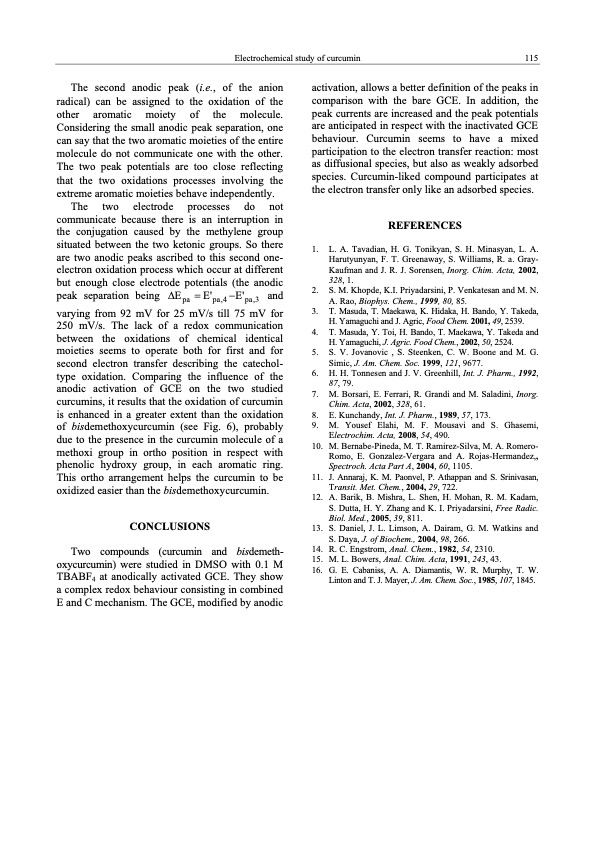
PDF Publication Title:
Text from PDF Page: 007
Electrochemical study of curcumin 115 The second anodic peak (i.e., of the anion radical) can be assigned to the oxidation of the other aromatic moiety of the molecule. Considering the small anodic peak separation, one can say that the two aromatic moieties of the entire molecule do not communicate one with the other. The two peak potentials are too close reflecting that the two oxidations processes involving the extreme aromatic moieties behave independently. The two electrode processes do not communicate because there is an interruption in the conjugation caused by the methylene group situated between the two ketonic groups. So there are two anodic peaks ascribed to this second one- electron oxidation process which occur at different but enough close electrode potentials (the anodic peak separation being ∆Epa = E'pa,4 −E'pa,3 and varying from 92 mV for 25 mV/s till 75 mV for 250 mV/s. The lack of a redox communication between the oxidations of chemical identical moieties seems to operate both for first and for second electron transfer describing the catechol- type oxidation. Comparing the influence of the anodic activation of GCE on the two studied curcumins, it results that the oxidation of curcumin is enhanced in a greater extent than the oxidation of bisdemethoxycurcumin (see Fig. 6), probably due to the presence in the curcumin molecule of a methoxi group in ortho position in respect with phenolic hydroxy group, in each aromatic ring. This ortho arrangement helps the curcumin to be oxidized easier than the bisdemethoxycurcumin. CONCLUSIONS Two compounds (curcumin and bisdemeth- oxycurcumin) were studied in DMSO with 0.1 M TBABF4 at anodically activated GCE. They show a complex redox behaviour consisting in combined E and C mechanism. The GCE, modified by anodic activation, allows a better definition of the peaks in comparison with the bare GCE. In addition, the peak currents are increased and the peak potentials are anticipated in respect with the inactivated GCE behaviour. Curcumin seems to have a mixed participation to the electron transfer reaction: most as diffusional species, but also as weakly adsorbed species. Curcumin-liked compound participates at the electron transfer only like an adsorbed species. REFERENCES 1. L. A. Tavadian, H. G. Tonikyan, S. H. Minasyan, L. A. Harutyunyan, F. T. Greenaway, S. Williams, R. a. Gray- Kaufman and J. R. J. Sorensen, Inorg. Chim. Acta, 2002, 328, 1. 2. S. M. Khopde, K.I. Priyadarsini, P. Venkatesan and M. N. A. Rao, Biophys. Chem., 1999, 80, 85. 3. T. Masuda, T. Maekawa, K. Hidaka, H. Bando, Y. Takeda, H. Yamaguchi and J. Agric, Food Chem. 2001, 49, 2539. 4. T. Masuda, Y. Toi, H. Bando, T. Maekawa, Y. Takeda and H. Yamaguchi, J. Agric. Food Chem., 2002, 50, 2524. 5. S. V. Jovanovic , S. Steenken, C. W. Boone and M. G. Simic, J. Am. Chem. Soc. 1999, 121, 9677. 6. H. H. Tonnesen and J. V. Greenhill, Int. J. Pharm., 1992, 87, 79. 7. M. Borsari, E. Ferrari, R. Grandi and M. Saladini, Inorg. Chim. Acta, 2002, 328, 61. 8. E. Kunchandy, Int. J. Pharm., 1989, 57, 173. 9. M. Yousef Elahi, M. F. Mousavi and S. Ghasemi, Electrochim. Acta, 2008, 54, 490. 10. M. Bernabe-Pineda, M. T. Ramirez-Silva, M. A. Romero- Romo, E. Gonzalez-Vergara and A. Rojas-Hermandez,, Spectroch. Acta Part A, 2004, 60, 1105. 11. J. Annaraj, K. M. Paonvel, P. Athappan and S. Srinivasan, Transit. Met. Chem., 2004, 29, 722. 12. A. Barik, B. Mishra, L. Shen, H. Mohan, R. M. Kadam, S. Dutta, H. Y. Zhang and K. I. Priyadarsini, Free Radic. Biol. Med., 2005, 39, 811. 13. S. Daniel, J. L. Limson, A. Dairam, G. M. Watkins and S. Daya, J. of Biochem., 2004, 98, 266. 14. R. C. Engstrom, Anal. Chem., 1982, 54, 2310. 15. M. L. Bowers, Anal. Chim. Acta, 1991, 243, 43. 16. G. E. Cabaniss, A. A. Diamantis, W. R. Murphy, T. W. Linton and T. J. Mayer, J. Am. Chem. Soc., 1985, 107, 1845.PDF Image | ELECTROCHEMICAL STUDY OF CURCUMIN on carbon Electrode

PDF Search Title:
ELECTROCHEMICAL STUDY OF CURCUMIN on carbon ElectrodeOriginal File Name Searched:
electrochemical-curcumin.pdfDIY PDF Search: Google It | Yahoo | Bing
CO2 Organic Rankine Cycle Experimenter Platform The supercritical CO2 phase change system is both a heat pump and organic rankine cycle which can be used for those purposes and as a supercritical extractor for advanced subcritical and supercritical extraction technology. Uses include producing nanoparticles, precious metal CO2 extraction, lithium battery recycling, and other applications... More Info
Heat Pumps CO2 ORC Heat Pump System Platform More Info
| CONTACT TEL: 608-238-6001 Email: greg@infinityturbine.com | RSS | AMP |